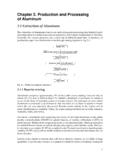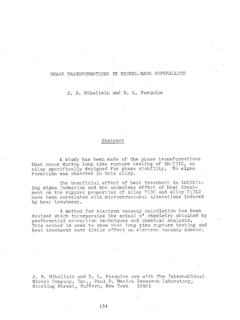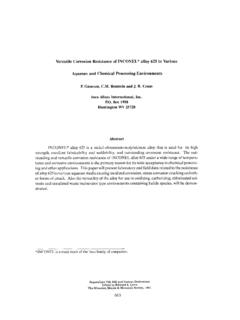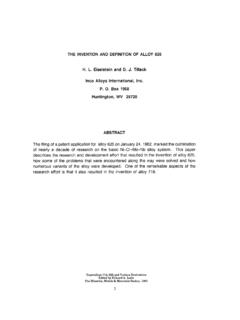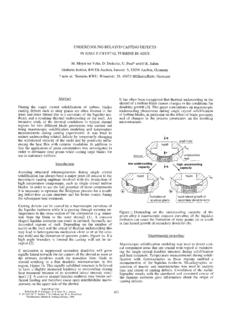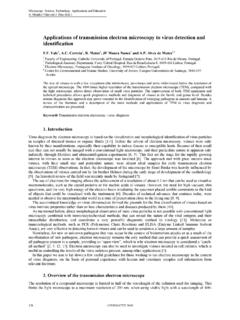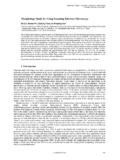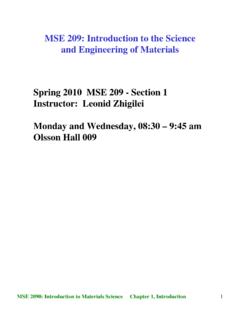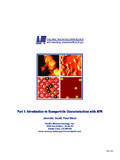Transcription of STRUCTURAL STABILITY OF MAR-M-509 - …
1 STRUCTURAL STABILITY OF MAR-M-509 - BASE SUPERALLOY J. M. Drapier, V. Leroy, C. DuPont, D. Coutsouradis, L:Habraken* Abstract of MAR-M-509 alloy ( * - - 1 ONi - .7W ;' - - O.'5Zr - - bal Co) was studied in ,the as-cast condition and, after prolonged exposure at ele- vated temperature, by optical microscopy, electron microscopy,. X-ray diffraction, and electron-probe analysis. Tensile prop- erties at room temperature were also determined after long- time exposure or creep 'at high temperature; - Research Metallurgist at CNRM and Assistant at the University of Liege - Research Metallurgist at CNRM - Research Engineer at FN - Head of Department at CNRM - Chief Research Metallurgist at CNRM and Associate Professor at the University of Lisge.
2 436 STRUCTURAL STABILITY OF MAR-M-509 - A COBALT-BASE SUPERALLOY introduction MAR-M-509 is a cast-cobalt superalloy developed by the Martin Metals Corporation for use at elevated temperatures.'? The purpose of the present investigation was to determine the phases present in the alloy in the as-cast condition and, also, those forming after prolonged expo- sure at elevated temperature. The microstructures of the experimental alloys were studied by means of optical microscopy, thin-foil transmission electron microscopy and diffraction,. X-ray diffraction of isolated parti- cles, and electron-microprobe analysis.
3 The effect of prolonged exposure at elevated temperature on the room-temperature mechanical properties of the alloy was also evaluated. EXPERIMENTAL ALLOYS The nominal composition of the MAR-M-509 is given in Table 1. The three alloys considered in this investigation were Alloy A. Two plates of 100 x 40 x 7 mm3 of MAR-M-509 alloy were made available to us by the Martin Metals Research Laboratories. Alloy B. A melt of the alloy was prepared at CNRM in a vacuum induction furnace and cast in the form of bars of 50-mm diameter. Alloy C. Melting stock of the alloy originating from Martin &tals was remelted in vacuum and precision cast in the form of tensile-test pieces.
4 In the subsequent sections the samples used will be referred to as Alloys A, B, and C, respectively. * H. L. Wheaton, Cobalt, No. 29, December 1965. 437 MICROSTRUCTURE IN THE AS-CAST CONDITION The microstructure of the alloy in the as-cast condition as revealed with the light microscope is illustrated inFigure 1. Four different phases can be distinguished: (1) The matrix (Dl in Figure la) (2) A roughly etched phase or aggregate (Al in Figure la). This phase was often observed-near or within the eutectic (Phase 4). (3) A bright-gray carbide that forms irregularly shaped aggregates (Bl and B or B' in Figures la and lc, respectively.)
5 (4) A eutectic-type mixture of carbide and matrix (Cl and C in Figure la and Id, respectively). Transmission-electron-microscopy examination'of the alloys in the as-cast condition showed that the matrix was essentially fee with stacking faults ( ). Only MC-type carbides were identified by electron diffraction. Furthermore, X-ray diffraction of isolated particles unambigusously revealed the presence of MC and the probable presence of M23C6 carbides. Further information on the nature and composition of the' phases present was obtained by the analysis of the phases with the electron microprobe.
6 Table 2 reproduces the compositions of the different phases of the three alloys investigated. In spite of the different origins of the samples investigated, Table 2 shows that the different phases have basically the same composi- tion, although variations are observed from one sample to the other or even within a single sample. The matrix is slightly enriched in chro- mium and nickel and slightly impoverished in tungsten. The content of tantalum, titanium, and zirconium in the matrix is appreciably lower than those in the nominal composition.
7 The irregularly shaped rod-type phase (Bl, B, or B' phase) is highly rich in tantalum and corresponds, thus, to an MC-type carbide. The latter also contains most of the titanium and zirconium present in the alloy, a fair quantity of tungsten, and minor quantities of the other addition elements. 438 The roughly etched globular phase (Al type) is characterized by high chromium and tungsten contents. The precise identification of this phase is not as yet possible. Although X-ray or electron diffrac- tion of extraction replicas does not contradict the presence of an SC-type carbide, the tungsten and chromium contents of this phase are in conflict with such an assumption.
8 The data obtained on the eutectic aggregate (Cl or C phase) show clearly that it consists of a high-chromium carbide and a cobalt- base solid solution, the composition of which is similar to that of the alloy matrix. The carbide phase in this eutectic is interpreted C zida:uz?.tgn carbide that has dissolved appreciable amqunts of cobalt . The distribution of the different elements among the carbide phases was further assessed by means of electron-probe scanning images obtained, with the radiation corresponding to different elements. Fig- ure 3 reproduces the images obtained on the region marked aa' and bb' in Figure lc.
9 These images confirm that the MC-type carbide is en- riched in tantalum, zirconium, and titanium and that it is impoverished in chromium, cobalt, and nickel. Tungsten appears to be uniformly dis- tributed between the matrix and the carbide. MICROSTRUCTURES IN THE AGED CONDITION Hardening Response The hardening response of MAR-M-509 during aging at elevated temperature is shown in Table 3. The hardening is appreciable after only 10 hours at temperature. At 800 C a continual hardening is ob- served. At 900 C the hardness level remains constant after the initial increase, but decreases after 4,500 hours of exposure.
10 At 950 C and 1100 C the hardness values indicate an overaging phenomenon or the solutioning of some of the initially present carbides. Optical Microscopy Figures 4 to 7 reproduce the microstructures of the alloy after aging for varying times at 800, 900, 950, and 1100 C, respectively. In the initial as-cast structure (Figure 1), the matrix appears essen- tially free of any precipitation. After aging at high temperature, an abundant precipitation is observed, particularly near the eutectic and globular initial precipitates. The morphology of the latter changes 439 appreciably as the t'ime of aging increases at 950 C and 1100 C.

